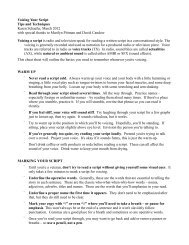The destructive wave <strong>of</strong> coal ash that breached its containment (upper left) at the TVA’s Kingston Fossil Plant was photographed by DotGriffith, with aviation assistance from SouthWings (www.southwings.org). For more about Griffith’s experience, see:http://freakonomics.blogs.nytimes.com/2009/01/08/the-tennessee-coal-ash-spill-in-pictures ). Photo © Dot Griffith Photography.Appalachian Voices, an environmental organization whose statedmission “is to empower people to defend our region's rich naturaland cultural heritage by providing them with tools and strategiesfor successful grassroots campaigns.”Here is Kovarik's response, written in mid-March. In it, hediscusses news coverage <strong>of</strong> the Tennessee spill and its relationshipto discoveries made by activists:***The TVA coal fly ash disaster marked a turning point forenvironmental reporting and environmental activism.For the first time, the media had sampling results fromenvironmental organizations almost right away. Robert F.Kennedy Jr.'s Riverkeepers, especially, were very active ingathering samples and getting them to university (AppalachianState University) and government toxicology labs.The results completely contradicted TVA's attempts at publicrelations. TVA said there was nothing to worry about, and theenvironmental groups not only said this was a cover-up, but theyalso proved it within a few days <strong>of</strong> the disaster.Typically, the cycle <strong>of</strong> disaster reporting goes something likethis: Disaster occurs, media summarizes; government agencytests, media reports, environmental groups react. Within a week,everyone is clamoring to see the agency test results. FOIA requestsare filed. Complaints are made. A month goes by, and thetest results come out, and even if the results are fairly serious, thecontroversy ebbs away.The typical cycle was broken wide open in the TVA disaster.News organizations were in the air taking photos, and environmentalgroups were in the water taking samples, within hours <strong>of</strong>the disaster.Video, posted by Appalachian Voices on YouTube, showedthe samples being taken, it showed the Appalachian StateUniversity toxicology lab, and it showed the test process.There was solid and very credible information that the agencywas doing something wrong. TVA said they found arsenic in theriver at 40 times below the drinking water standard, but thecontinued on page 2218 SEJournal Winter 2008
Mainstream coverage<strong>of</strong> coal ash wins praiseWriting for CJR.org, Curtis Brainard praised a number <strong>of</strong>local and regional newspapers for their coverage in theimmediate aftermath <strong>of</strong> the huge coal ash spill in Tennessee lastDecember:***Local media jumped on the story, covering the extent thedamage, the response by the TVA (Tennessee Valley Authority)and the <strong>Environmental</strong> Protection Agency, estimates <strong>of</strong> thevarious health risks, and issues surrounding waste ponds generally.The Nashville Tennessean, the Knoxville News Sentinel, and theChattanooga Times Free Press, deserve particular credit, as doThe Post and Courier in Charleston, South Carolina, TheCharleston Gazette in West Virginia, The Courier-Journal inLouisville, and the Pittsburgh Post-Gazette for placing the storyin a broader, regional context. A refrain throughout that reportingwas the point that coal ash, leftover from burning, is pro<strong>of</strong> thatcoal is (and always will be) dirty.***Here's a sampling <strong>of</strong> some stories that show how coverage <strong>of</strong>the issue changed and grew in the months that followed theTennessee spill.That incident occurred three days before Christmas. Coverageby both local and national news outlets had begun to includebroader-focus explanatory and investigative stories by New Year'sEve and New Year's Day.On Dec. 31, for instance, Bloomberg's Alex Nussbaum,Christopher Martin and Daniel Whitten reported that “U.S.power companies may face billions <strong>of</strong> dollars a year in new costsafter last week’s coal-sludge spill in east Tennessee if the accidentresults in regulating their wastes as toxic,” noting that such“proposals stalled during the eight years <strong>of</strong> President George W.Bush's administration.”On Jan. 1, Scott Barker <strong>of</strong> the News Sentinel reported that aTVA inspection report in February 2008 had indicated the “agencyknew about leaks at the (spill) site for more than two decades andopted not to pay for long-term solutions to the problem.”That same day, Richard Fausset <strong>of</strong> the Los Angeles Timesreported on health and economic concerns near the spill site, theKingston Fossil Plant:***No one was harmed, but residents are worried about the longtermhealth effects from the ash, which contains potentiallyharmful contaminants such as arsenic. They are also worried aboutthe threats to their economy and culture, long defined by thepicturesque waterways that snake through the lush Appalachianhill country.A few days later, The New York Times and The AssociatedPress produced detailed reports on the national dimensions <strong>of</strong>potentially problematical coal ash disposal sites.On Jan. 6, the Times' Shaila Dewan reported that theTennessee spill site “was only one <strong>of</strong> more than 1,300 similardumps across the United States — most <strong>of</strong> them unregulated andunmonitored — that contain billions more gallons <strong>of</strong> fly ash andother byproducts <strong>of</strong> burning coal.”Three days later, AP reporter Dina Cappiello wrote about heranalysis <strong>of</strong> “the most recent Energy Department data,” whichrevealed that “156 coal-fired power plants store ash in surfaceponds similar to one that ruptured last month in Tennessee.”Taking the big-picture approach further, the Center for PublicIntegrity, a non-pr<strong>of</strong>it investigative reporting organization basedin Washington, D.C., on Feb. 19 posted on its website a reportheadlined “Coal Ash: The Hidden Story / How Industry and theEPA Failed to Stop a Growing <strong>Environmental</strong> Disaster.” Includedwas an interactive map <strong>of</strong> coal ash ponds and landfills across thecountry.Beyond Appalachia, reporters were already localizing thestory before the CPI report helped make that easier to do.On Jan. 1, Perry Beeman reported in The Des MoinesRegister that Iowa <strong>of</strong>ficials were postponing action on proposedrules to require landfill liners and monitoring for coal ash disposalafter industry representatives “questioned the true health risk andobjected to potential costs.”Three days later, L. Lamor Williams <strong>of</strong> the ArkansasDemocrat-Gazette had a story reporting that “environmentalregulators and company <strong>of</strong>ficials” were saying there was no risk inthat state <strong>of</strong> a catastrophic spill like the one in neighboringTennessee because the same method for storing ash is not used inArkansas.Bordering Arksansas' southwestern corner, Texas is the largestconsumer <strong>of</strong> coal in the U.S. As Randy Lee L<strong>of</strong>tis reported in TheDallas Morning News on March 13, the state also leads the nationin “current and proposed production <strong>of</strong> the waste.”In the weeks before that article appeared, Texas reportersalready were focusing on the issue in different ways.On Jan. 22, Jeanne Williams reported in the Temple DailyTelegram that a state report listed neighboring Milam County's314,400 tons <strong>of</strong> the waste as Texas' largest amount stored. OnMarch 13, Williams reported on proposed state legislation toregulate coal ash as hazardous.On Jan. 23, The Texas Observer, a biweekly publication basedin Austin, had published an article by Forrest Wilder reportingconcerns among environmentalists and some Texas lawmakersabout inadequate regulation. Wilder’s review <strong>of</strong> state rules foundthat operators <strong>of</strong> the state's 17 coal-burning power plants don’thave to get a permit to dump the waste (totaling 13 million tons peryear) in landfills and ponds.Not all coal ash coverage in Texas was directly related toutilities' power plants. Greg M. Schwartz took an in-depth lookin the weekly San Antonio Current's Jan. 21 issue at healthconcerns prompted by the local public housing agency'sexcavation <strong>of</strong> a site where ash from the boiler <strong>of</strong> a defunctmeat-packing plant had been dumped.Bill Dawson is assistant editor <strong>of</strong> the SEJournal.19 SEJournal Spring 2009












